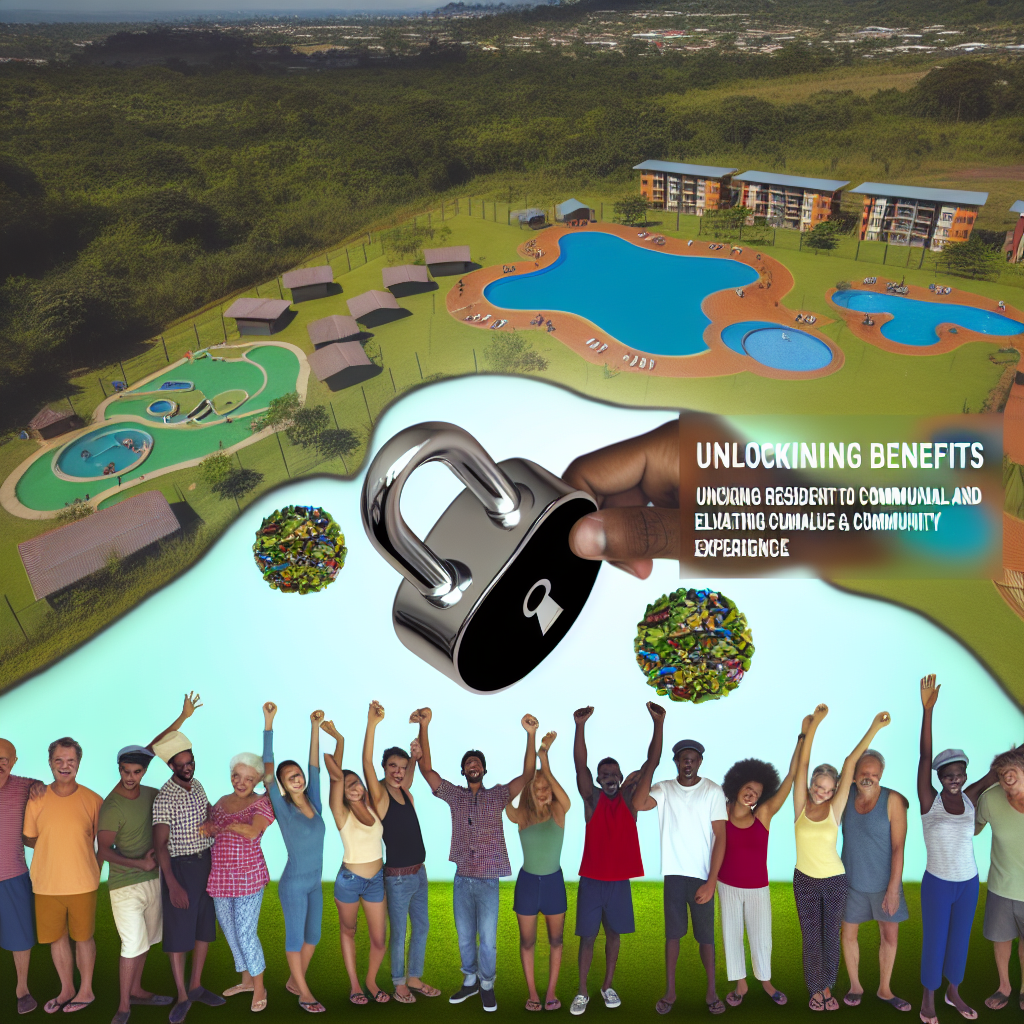Maximizing Resident Benefits: Top Community Amenities to Enhance Tenant Experience in 2025
As we approach 2025, the landscape of residential living continues to evolve, with a growing emphasis on enhancing tenant experiences through community amenities. This shift is driven by the increasing demand for living environments that not only provide shelter but also foster a sense of community and well-being. To maximize resident benefits, property developers and managers are focusing on integrating top-tier amenities that cater to the diverse needs of modern tenants. By doing so, they aim to create vibrant communities that enhance the quality of life for all residents.
One of the most significant trends in community living is the incorporation of wellness-focused amenities. As health and well-being become paramount, residential communities are prioritizing features such as state-of-the-art fitness centers, yoga studios, and meditation gardens. These facilities provide residents with convenient access to physical and mental health resources, promoting a balanced lifestyle. Additionally, the inclusion of outdoor spaces, such as walking trails and rooftop gardens, encourages residents to engage with nature, further contributing to their overall well-being.
Moreover, the integration of technology-driven amenities is transforming the residential experience. Smart home technologies, such as keyless entry systems, smart thermostats, and app-controlled lighting, offer residents enhanced convenience and security. Furthermore, high-speed internet and dedicated co-working spaces are becoming essential, particularly as remote work continues to be a prevalent trend. These technological advancements not only improve the daily lives of residents but also attract tech-savvy individuals seeking modern living solutions.
In addition to wellness and technology, fostering a sense of community is crucial in enhancing tenant experiences. Communal spaces, such as lounges, game rooms, and shared kitchens, provide opportunities for social interaction and community building. Regularly organized events, such as movie nights, cooking classes, and fitness workshops, further encourage residents to connect with one another. By creating an environment that promotes social engagement, residential communities can cultivate a strong sense of belonging among their residents.
Sustainability is another key consideration in the development of community amenities. As environmental consciousness grows, residents are increasingly seeking eco-friendly living options. To address this demand, property developers are incorporating sustainable features such as solar panels, energy-efficient appliances, and recycling programs. These initiatives not only reduce the environmental impact of residential communities but also appeal to environmentally conscious tenants who prioritize sustainable living practices.
Furthermore, pet-friendly amenities are gaining popularity as more residents consider their pets as integral members of their households. Dog parks, pet washing stations, and pet-friendly events are becoming common features in residential communities. By accommodating the needs of pet owners, these communities can attract a broader range of tenants and enhance the overall living experience for pet-loving residents.
In conclusion, as we look towards 2025, the enhancement of tenant experiences through community amenities is becoming increasingly important. By focusing on wellness, technology, community building, sustainability, and pet-friendly features, residential communities can maximize resident benefits and create environments that cater to the diverse needs of modern tenants. These actionable insights not only improve the quality of life for residents but also contribute to the long-term success and appeal of residential properties. As the demand for enriched living experiences continues to grow, property developers and managers must remain proactive in adapting to these evolving trends to ensure the satisfaction and well-being of their residents.
Elevating Community Value: Innovative Property Perks for Convenient Living
As we approach 2025, the landscape of community living is evolving, with a focus on enhancing resident benefits and elevating the overall value of properties. This shift is driven by the increasing demand for convenience, sustainability, and a sense of belonging among residents. Property developers and managers are now tasked with the challenge of integrating innovative perks that not only meet these demands but also set their communities apart in a competitive market. To achieve this, a multifaceted approach is essential, one that combines technology, sustainability, and community engagement.
One of the most significant trends in enhancing community value is the integration of smart technology. Smart home features, such as automated lighting, climate control, and security systems, are becoming standard expectations among residents. These technologies not only offer convenience but also contribute to energy efficiency, aligning with the growing emphasis on sustainability. Moreover, the implementation of community-wide Wi-Fi and app-based platforms for managing maintenance requests and community announcements further streamlines communication and fosters a connected living environment.
In addition to technological advancements, sustainability initiatives are playing a crucial role in elevating community value. Developers are increasingly incorporating green building practices, such as solar panels, rainwater harvesting systems, and energy-efficient appliances, into their projects. These features not only reduce the environmental footprint of the community but also result in long-term cost savings for residents. Furthermore, the inclusion of green spaces, community gardens, and walking trails promotes a healthy lifestyle and enhances the aesthetic appeal of the property.
Community engagement is another critical component in enhancing resident benefits. Creating spaces and opportunities for social interaction fosters a sense of belonging and community spirit. This can be achieved through the development of communal areas such as clubhouses, co-working spaces, and recreational facilities. Organizing regular events, workshops, and activities also encourages residents to connect and engage with one another, thereby strengthening community ties.
Moreover, offering personalized services and amenities can significantly enhance the living experience. Concierge services, package delivery lockers, and on-site fitness centers are just a few examples of amenities that cater to the diverse needs of residents. By providing these conveniences, property managers can create a more comfortable and enjoyable living environment, ultimately increasing resident satisfaction and retention.
As we look towards 2025, it is clear that the integration of innovative property perks is essential for elevating community value. By embracing smart technology, sustainability initiatives, and community engagement, property developers and managers can create living environments that not only meet the evolving needs of residents but also stand out in a competitive market. The focus on convenience, sustainability, and a sense of belonging will continue to drive the development of residential communities, ensuring that they remain attractive and valuable to current and prospective residents alike.
In conclusion, the future of community living lies in the ability to adapt and innovate. By prioritizing resident benefits and enhancing community value through actionable insights, property developers and managers can create thriving communities that offer a superior living experience. As we move forward, it is imperative to remain attuned to the changing needs and preferences of residents, ensuring that communities continue to evolve and flourish in the years to come.
On-Site Trash Solutions: Streamlining Waste Management for Improved Resident Satisfaction
In the evolving landscape of residential community management, the focus on enhancing resident satisfaction has never been more pronounced. As we look towards 2025, one area that holds significant potential for improvement is waste management. On-site trash solutions are increasingly being recognized as a pivotal component in streamlining operations and elevating the living experience for residents. By implementing efficient waste management systems, communities can not only enhance the aesthetic appeal of their surroundings but also contribute to environmental sustainability, thereby aligning with broader societal goals.
To begin with, the integration of advanced waste management technologies can significantly reduce the inconvenience associated with traditional trash disposal methods. For instance, the adoption of smart waste bins equipped with sensors can alert management when they are nearing capacity, thus ensuring timely collection and reducing overflow. This proactive approach not only minimizes unpleasant odors and unsightly trash accumulation but also fosters a cleaner and more hygienic environment. Consequently, residents are likely to experience a heightened sense of satisfaction, knowing that their community is committed to maintaining high standards of cleanliness and order.
Moreover, the implementation of on-site recycling programs can further enhance resident engagement and participation in sustainable practices. By providing clearly labeled recycling bins and educating residents on proper waste segregation, communities can encourage responsible disposal habits. This not only reduces the volume of waste sent to landfills but also promotes a culture of environmental stewardship among residents. As a result, communities that prioritize recycling initiatives are likely to see an increase in resident pride and a stronger sense of community identity.
In addition to technological advancements and recycling efforts, the strategic placement of waste disposal units plays a crucial role in optimizing convenience for residents. By ensuring that trash and recycling bins are easily accessible yet discreetly located, communities can strike a balance between functionality and aesthetics. This thoughtful placement reduces the likelihood of littering and encourages residents to dispose of waste responsibly. Furthermore, regular maintenance and cleaning of these areas are essential to prevent the buildup of debris and maintain a pleasant living environment.
Another key aspect of enhancing waste management is effective communication between management and residents. By keeping residents informed about waste collection schedules, recycling guidelines, and any changes to waste management policies, communities can foster a sense of transparency and trust. Additionally, soliciting feedback from residents on waste management practices can provide valuable insights into areas for improvement and innovation. This collaborative approach not only empowers residents but also ensures that management is responsive to their needs and concerns.
As we move towards 2025, it is imperative for residential communities to recognize the multifaceted benefits of efficient waste management systems. By embracing technological innovations, promoting recycling initiatives, optimizing the placement of disposal units, and maintaining open lines of communication, communities can significantly enhance resident satisfaction. Ultimately, these efforts contribute to a more sustainable and harmonious living environment, where residents feel valued and engaged. In this way, on-site trash solutions serve as a cornerstone for community living enhancement, paving the way for a future where resident benefits are seamlessly integrated with environmental responsibility.
Unlock the future of community living with actionable insights for 2025! Discover how resident benefits and community enhancements can transform your living experience. [Learn more now](https://americantrashservice.com).



